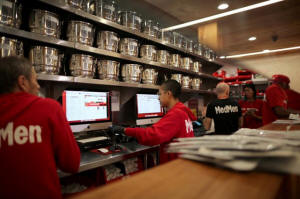|
Green Crack, Blue Dream, Gorilla Glue:
The problem of pricing pot
 Send a link to a friend
Send a link to a friend
 [March 15, 2018]
By Chris Prentice [March 15, 2018]
By Chris Prentice
NEW YORK (Reuters) - In 2014, as Jonathan
Rubin and Ian Laird considered investing in the booming U.S. cannabis
industry, they hit a problem: How to value pot starts-ups with little
verified data on the price of the weed itself?
While a smoker may know the going retail price for "Strawberry Diesel"
or "Buddha's Sister", the sector's wholesale tier still operates much
like a black market because of ongoing federal prohibition, despite
legalizations in 30 U.S. states and Washington D.C. since the 1990s.
That left Rubin and Laird puzzled on the investment value of a
dispensary, a weed farm or a factory making pot-infused candy. The
problem spawned a different investment: The founding of New Leaf Data
Services LLC, a Stamford, Conn.-based wholesale price data service that
fields reporters to take on the steep challenge of cataloguing going
rates.
Started three years ago, New Leaf now publishes weekly benchmark spot
prices and forecasts on wholesale indoor-, outdoor-, and
greenhouse-grown marijuana for 17 regions with legalization laws.

New Leaf makes money from about 350 pot proprietors and other
subscribers who buy reports and custom analytics. It has raised money
from investors who want exposure to the cannabis sector without the risk
of breaking federal law.
The model is roughly based on S&P Global Platts, a firm where Rubin once
worked that researches and publishes wholesale prices for crude oil,
fuel and other commodities such as metals or agricultural crops.
The task is much harder for pot, and New Leaf's experience stalking
prices sheds light on the murky trade of what might be the
fastest-growing U.S. commodity, sold legally and illegally for untold
billions of dollars.
Cannabis firms still deal almost exclusively in cash to avoid a paper
trail or because they have almost no access to banks and financial
services. Because it's illegal to transport the drug across state lines,
prices and available products vary widely in different regions based on
whether a state has both medical and recreational markets and the number
of licensed dispensaries and producers.
Last week, spot prices for flower in Alaska were $5,496 per lb, while
prices in Colorado and Oregon fell to historic lows of $1,008 and
$1,166, respectively, according to New Leaf.
(For a graphic on state marijuana laws and price differences, see:
http://tmsnrt.rs/2AFalvZ )
Legal pot prices are also impacted by supply and demand fluctuations in
the illegal market, and the spread between the two can vary.
In California, regulated market prices are more than $1,000 per lb,
whereas prices for illegal weed can be as low as $500 per lb, estimated
Scott Davies, a California cultivator. Legal market marijuana tends to
be more expensive because supplies are more restricted and because it is
taxed.

"Consider each state to be a different country when it comes to their
laws, amount of licenses issued, what the qualifying conditions are for
entry into their medical program, as well as what the political climate
and current illicit market looks like," said Nic Easley, one of New
Leaf's market consultants.
Easley, a disabled veteran of the U.S. Air Force, said he moved to
Colorado in 2006 to use cannabis to ease the pain of injuries. He's one
of New Leaf's team of a dozen price experts who chase down their market
data and intelligence through a network of commercial players and
cannabis industry groups, such as the Oregon Retailers of Cannabis
Association (ORCA). The data suppliers agree to submit weekly prices
anonymously and, in exchange, get discounted subscriptions or other
services.
LEGAL BUT UNDERGROUND
A multi-billion dollar cannabis industry has developed despite federal
prohibition, but many executives, farmers and employees are still wary
of federal prosecution.
Davies, a farmer in Humboldt County, California - a region renowned for
its premium cannabis – said growers have historically done and still do
handshake deals with counterparts vouched for by shared acquaintances.
Davies sells directly to dispensaries, essentially relying on the rumor
mill to set prices.
[to top of second column]
|

Employees prepare recreational marijuana orders for customers at the
MedMen store in West Hollywood, California, U.S., January 2, 2018.
REUTERS/Lucy Nicholson/File Photo

"It's all been word-of-mouth, through people we know and trust who
are established players," he said.
But the market in California - which recently legalized recreational
use - is evolving rapidly and becoming more like a traditional
industry, with buyers and sellers now sometimes meeting at industry
events, Davies said.
Market transparency has seen a boost from heightened regulations as
authorities in states like Oregon rolled out legal recreational
markets, said Casey Houlihan, head of ORCA.
Under the new rules in that state, dispensaries must purchase
cannabis from registered producers, who are required to track their
sales and report them to the government. Previously, dispensaries
could buy more liberally through a medical marijuana program.
The data New Leaf collects is still fairly rough, and the marijuana
market has nothing like national benchmark prices or futures
contracts common to other legal commodities trades. There's no real
way for businesses to hedge, and price-setting remains largely
guesswork, said Josh Richman, senior vice president of sales and
marketing for Franklin BioScience, which grows cannabis and
manufactures branded products, such as mints, in Colorado, Nevada
and Pennsylvania.
"There isn't something where I can sell long or short," he said.
GRAPHIC: U.S. legalization legislation and regional pot prices -
http://tmsnrt.rs/2AFalvZ

BLUE DREAM, GREEN CRACK AND GORILLA GLUE
The retail market is somewhat more transparent, and a pricing
service called BDS Analytics runs an online database of more than
140,000 types of pot and pot products. BDS sells pricing and
popularity data to retail shop owners.
Roy Bingham, who co-founded BDS Analytics in 2015, is a veteran of
the finance and consultancy industries.
"We knew this data is really invaluable for the retail business,"
Bingham said. "There are people in this industry who have been in
supply chains at Walmart, GNC and other mainstream operations."
His firm collects point-of-sales data from retailers and lists the
details for products such as "Blue Dream" and "Green Crack".
Joseph Hopkins, co-owner of a dispensary called The Greener Side in
Eugene, Oregon, uses the data to deal with suppliers.
"When vendors come in and say they have x, y, z products, I can go
back and look at whatever the going rate is for that product," he
said.
Still, the metrics are imperfect. State regulators increasingly
perform quality tests to ensure safety, but no one checks to make
sure that what someone is selling as “Green Crack” really matches
weed branded under the same name elsewhere.
The data show variations in demand for various brand among regions.
For example, Blue Dream has reigned as the most popular strain for
flower in Colorado and Washington since 2014. But in Oregon, tokers
favor a strain known as GG - formerly "Gorilla Glue," until its
purveyors got sued by the makers of the actual glue by the same
name.
(Reporting by Chris Prentice; Editing by Simon Webb and Brian
Thevenot)
[© 2018 Thomson Reuters. All rights
reserved.]
Copyright 2018 Reuters. All rights reserved. This material may not be published,
broadcast, rewritten or redistributed.
Thompson Reuters is solely responsible for this content.
 |